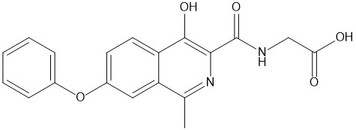Roxadustat | Prolyl hydroxylase domain inhibitor / HIF stabilizer

Available Options
| Size: | Price | Quantity | |
|---|---|---|---|
| 5 mg | $30.00 | ||
| 25 mg | $95.00 |
Roxadustat (808118-40-3) is a pan-prolyl hydroxylase domain (PHD) inhibitor (IC50 for PHD2 = 591 nM)1 that stabilizes hypoxia-inducible factor (HIF) leading to erythropoiesis. Currently in clinical trials for treatment of anemia related to chronic kidney disease.2 Roxadustat accelerated cutaneous wound healing and shortened healing time via improvement in epidermal stem cell proliferation and motility3 and increasing angiogenesis4. It displayed radioprotective effects in haematopoietic systems via up-regulation of HIF-1α.5 Roxadustat displayed protective effects against atherosclerosis via activation of adipose HIF-2α.6
References/Citations:
1) Lei et al. (2015) Affinity-Based Fluorescence Polarization Assay for High-Throughput Screening of Prolyl Hydroxylase 2 Inhibitors, ACS Med. Chem. Lett. 6 12367
2) Liu et al. (2020) Roxadustat (FG-4592) Treatment for Anemia in Dialysis-Dependent (DD) and Not Dialysis-Dependent (NDD) Chronic Kidney Disease Patients: A , Hemodial. Int. 21(Suppl. 1) S110
3) Tang et al. (2018) FG-4592 Accelerates Cutaneous Wound Healing by Epidermal Stem Cell Activation via HIF-1α Stabilization, Cell Physiol. Biochem. 46 2460
4) Zhu et al. (2019) Roxadustat Promotes Angiogenesis Through HIF-1α/VEGF/VEGFR2 Signaling and Accelerates Cutaneous Wound Healing in Diabetic Rats, Wound Repair Regen. 27 324
5) Zhang et al. (2019) Radioprotective effects of roxadustat (FG-4592) in haematopoietic system, J. Cell Mol. Med. 23 349
6) Zhang et al. (2019) Adipocyte Hypoxia-Inducible Factor 2α Suppresses Atherosclerosis by Promoting Adipose Ceramide Catabolism, Cell Metab.30 937
Safety Data Sheet:
Product Data Sheet:
Materials provided by Focus Biomolecules are for laboratory research use only and are not intended for human or veterinary applications. Please note that we do not sell to individuals and that all orders placed by non-research organizations will incur a $20 restocking/refund fee
Roxadustat (808118-40-3) is a pan-prolyl hydroxylase domain (PHD) inhibitor (IC50 for PHD2 = 591 nM)1 that stabilizes hypoxia-inducible factor (HIF) leading to erythropoiesis. Currently in clinical trials for treatment of anemia related to chronic kidney disease.2 Roxadustat accelerated cutaneous wound healing and shortened healing time via improvement in epidermal stem cell proliferation and motility3 and increasing angiogenesis4. It displayed radioprotective effects in haematopoietic systems via up-regulation of HIF-1α.5 Roxadustat displayed protective effects against atherosclerosis via activation of adipose HIF-2α.6
References/Citations:
1) Lei et al. (2015) Affinity-Based Fluorescence Polarization Assay for High-Throughput Screening of Prolyl Hydroxylase 2 Inhibitors, ACS Med. Chem. Lett. 6 12367
2) Liu et al. (2020) Roxadustat (FG-4592) Treatment for Anemia in Dialysis-Dependent (DD) and Not Dialysis-Dependent (NDD) Chronic Kidney Disease Patients: A , Hemodial. Int. 21(Suppl. 1) S110
3) Tang et al. (2018) FG-4592 Accelerates Cutaneous Wound Healing by Epidermal Stem Cell Activation via HIF-1α Stabilization, Cell Physiol. Biochem. 46 2460
4) Zhu et al. (2019) Roxadustat Promotes Angiogenesis Through HIF-1α/VEGF/VEGFR2 Signaling and Accelerates Cutaneous Wound Healing in Diabetic Rats, Wound Repair Regen. 27 324
5) Zhang et al. (2019) Radioprotective effects of roxadustat (FG-4592) in haematopoietic system, J. Cell Mol. Med. 23 349
6) Zhang et al. (2019) Adipocyte Hypoxia-Inducible Factor 2α Suppresses Atherosclerosis by Promoting Adipose Ceramide Catabolism, Cell Metab.30 937
Calculate the molar concentration, mass or volume in a solution.
Concentration × Volume × Molecular Weight = Mass
Focus Biomolecules • Plymouth Meeting, PA USA • 1-855-FOCUS21
Focus Biomolecules
Plymouth Meeting, PA USA
1-855-FOCUS21
Website Created by Advanta Advertising LLC.

